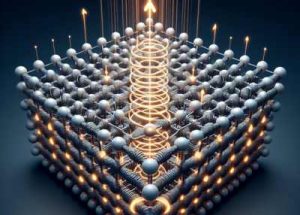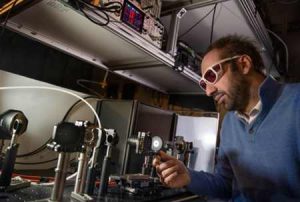From Stockholm University, Quantum Breakthrough When Light Makes Materials Magnet
Breakthrough expected to pave way for faster and more energy-efficient computers, information transfer and storage.
This is a Press Release edited by StorageNewsletter.com on April 19, 2024 at 4:01 pmFrom Stockholm University
The potential of quantum technology is huge but is today largely limited to the extremely cold environments of laboratories.
The laser light is circularly polarized, i.e. the light has the shape of a ‘corkscrew’. When laser light with this type of polarization enters a material, it transfers its circular polarization to the atoms in it, by making them rotate and generate atomic currents. If the frequency of the light matches the frequency of vibration of the atoms, the effect is enhanced and a relatively large magnetism is generated.
(AI generated image by Alexander Balatsky)
Now, researchers at Stockholm University, at the Nordic Institute for Theoretical Physics (NORDITA) and at the Ca’ Foscari University of Venice have succeeded in demonstrating for the 1st time how laser light can induce quantum behavior at room temperature – and make non-magnetic materials magnetic. The breakthrough is expected to pave the way for faster and more energy-efficient computers, information transfer and storage.
Within a few decades, the advancement of quantum technology is expected to revolutionize several of society’s most important areas and pave the way for completely new technological possibilities in communication and energy. Of particular interest for researchers in the field are the peculiar and bizarre properties of quantum particles – which deviate completely from the laws of classical physics and can make materials magnetic or superconducting. By increasing the understanding of exactly how and why this type of quantum states arise, the goal is to be able to control and manipulate materials to obtain quantum mechanical properties.
So far, researchers have only been able to induce quantum behaviors, such as magnetism and superconductivity, at extremely cold temperatures. Therefore, the potential of quantum research is still limited to laboratory environments.
Laser light induce magnetism at room temperature
Stefano Bonetti in the lab at Stockholm University.
(Photo: Knut and Alice Wallenberg Foundation/Magnus Bergström)
Now, a research team from Stockholm University and the Nordic Institute of Theoretical Physics (NORDITA)* in Sweden, the University of Connecticut and the SLAC National Accelerator Laboratory in USA, the National Institute for Materials Science in Tsukuba, Japan, the Elettra-Sincrotrone Trieste, the ‘Sapienza’ University of Rome and the Ca’ Foscari University of Venice in Italy, is the 1st in the world to demonstrate in an experiment how laser light can induce magnetism in a non-magnetic material at room temperature. In the study, published in Nature (see below), the researchers subjected the quantum material strontium titanate to short but intense laser beams of a peculiar wavelength and polarization, to induced magnetism.
“The innovation in this method lies in the concept of letting light move atoms and electrons in this material in circular motion, so to generate currents that make it as magnetic as a refrigerator magnet. We have been able to do so by developing a new light source in the far-infrared with a polarization which has a ‘corkscrew’ shape. This is the first time we have been able to induce and clearly see how the material becomes magnetic at room temperature in an experiment. Furthermore, our approach allows to make magnetic materials out of many insulators, when magnets are typically made of metals. In the long run, this opens for completely new applications in society,” says Stefano Bonetti, research leader, Stockholm University and Ca’ Foscari University of Venice.
Broad applications for information technologies
The method is based on the theory of ‘dynamic multiferroicity,’ which predicts that when titanium atoms are ‘stirred up’ with circularly polarized light in an oxide based on titanium and strontium, a magnetic field will be formed. But it is only now that the theory can be confirmed in practice. The breakthrough is expected to have broad applications in several information technologies.
![]() “This opens up for ultra-fast magnetic switches that can be used for faster information transfer and considerably better data storage, and for computers that are significantly faster and more energy-efficient,” says Alexander Balatsky, professor, physics, NORDITA.
“This opens up for ultra-fast magnetic switches that can be used for faster information transfer and considerably better data storage, and for computers that are significantly faster and more energy-efficient,” says Alexander Balatsky, professor, physics, NORDITA.
In fact, the results of the team have already been reproduced in several other labs, and a publication in the same issue of Nature demonstrates that this approach can be used to write, and hence store, magnetic information. A new chapter in designing new materials using light has been opened.
The research project has been funded by the Knut and Alice Wallenberg Foundation and an ERC Synergy Grant.
(*) The Nordic Institute for Theoretical Physics (NORDITA) is a collaboration between the 5 Nordic countries. Since 2007, Nordita has been located at the Albanova university campus in Stockholm, with Stockholm University and KTH Royal Institute of Technology as the host universities.
Article: Terahertz electric-field-driven dynamical multiferroicity in SrTiO3
Nature has published an article written by M. Basini, Department of Physics, Stockholm University, Stockholm, Sweden , M. Pancaldi, Department of Molecular Sciences and Nanosystems, Ca’ Foscari University of Venice, Venice, Italy, and Elettra-Sincrotrone Trieste S.C.p.A., Basovizza, Italy , B. Wehinger, Department of Molecular Sciences and Nanosystems, Ca’ Foscari University of Venice, Venice, Italy, and European Synchrotron Radiation Facility, Grenoble, France, M. Udina, Department of Physics and ISC-CNR, ‘Sapienza’ University of Rome, Rome, Italy, V. Unikandanunni, Department of Physics, Stockholm University, Stockholm, Sweden, T. Tadano, Research Center for Magnetic and Spintronic Materials, National Institute for Materials Science, Tsukuba, Japan , M. C. Hoffmann, Linac Coherent Light Source, SLAC National Accelerator Laboratory, Menlo Park, CA, USA , A. V. Balatsky, Department of Molecular Sciences and Nanosystems, Ca’ Foscari University of Venice, Venice, Italy, NORDITA, Stockholm, Sweden, Department of Physics, University of Connecticut, Storrs, CT, USA, and Rara Foundation – Sustainable Materials and Technologies, Venice, Italy, and S. Bonetti, Department of Physics, Stockholm University, Stockholm, Sweden, Department of Molecular Sciences and Nanosystems, Ca’ Foscari University of Venice, Venice, Italy, and Rara Foundation – Sustainable Materials and Technologies, Venice, Italy
Abstract: “The emergence of collective order in matter is among the most fundamental and intriguing phenomena in physics. In recent years, the dynamical control and creation of novel ordered states of matter not accessible in thermodynamic equilibrium is receiving much attention1,2,3,4,5,6. The theoretical concept of dynamical multiferroicity has been introduced to describe the emergence of magnetization due to time-dependent electric polarization in non-ferromagnetic materials7,8. In simple terms, the coherent rotating motion of the ions in a crystal induces a magnetic moment along the axis of rotation. Here we provide experimental evidence of room-temperature magnetization in the archetypal paraelectric perovskite SrTiO3 due to this mechanism. We resonantly drive the infrared-active soft phonon mode with an intense circularly polarized terahertz electric field and detect the time-resolved magneto-optical Kerr effect. A simple model, which includes two coupled nonlinear oscillators whose forces and couplings are derived with ab initio calculations using self-consistent phonon theory at a finite temperature9, reproduces qualitatively our experimental observations. A quantitatively correct magnitude was obtained for the effect by also considering the phonon analogue of the reciprocal of the Einstein–de Haas effect, which is also called the Barnett effect, in which the total angular momentum from the phonon order is transferred to the electronic one. Our findings show a new path for the control of magnetism, for example, for ultrafast magnetic switches, by coherently controlling the lattice vibrations with light.“

















 Subscribe to our free daily newsletter
Subscribe to our free daily newsletter

